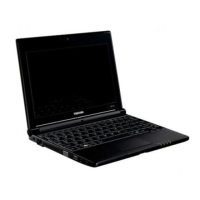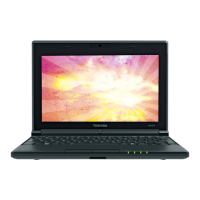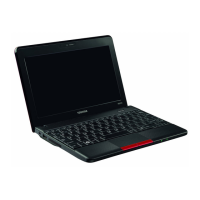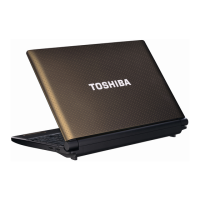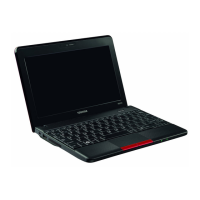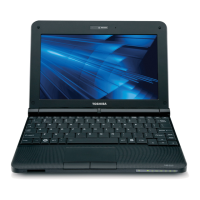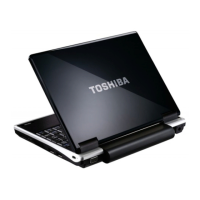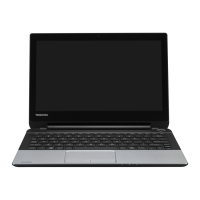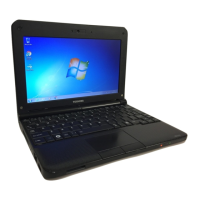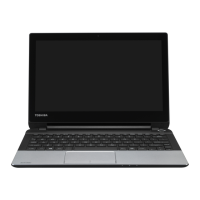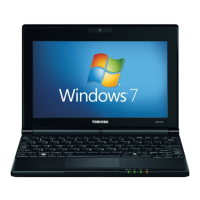
Do you have a question about the Toshiba NB500 Series and is the answer not in the manual?
| Resolution | 1024 x 600 |
|---|---|
| Operating System | Windows 7 Starter |
| Graphics | Intel GMA 3150 |
| Wireless | 802.11 b/g/n |
| USB Ports | 3 x USB 2.0 |
| Battery | 6-cell Lithium-ion |
| RAM | 1GB DDR3 |
| Storage | 250GB HDD |
| Display | 10.1-inch |
| LAN | 10/100 Ethernet |
| Card Reader | SD/SDHC |
| Ports | VGA, Headphone, Microphone |
Details how power conditions affect computer operation and battery status.
Outlines a systematic method for diagnosing and resolving computer issues.
Lists basic checks for common issues before advanced troubleshooting.
Explains how to connect the AC adaptor and open the display.
Guides on turning the computer on, starting up, and shutting down.
Provides step-by-step instructions for connecting the AC adaptor.
Lists critical safety warnings for using the AC adaptor.
Details the procedure for turning on the computer.
Guides through the initial operating system setup.
Lists advantages of using Hibernation Mode.
Details how to initiate Hibernation Mode.
Covers automatic hibernation settings and data saving.
Explains various methods to restart the computer.
Identifies key components like Web Camera, Microphone, Keyboard, and Display Screen.
Details Touch Pad, its buttons, and the Power button.
Explains wireless antennas, web camera operation, and LED indicators.
Details microphone function and display screen resolution/brightness.
Explains Power button, LCD Sensor switch, and display hinges.
Details keyboard, touch pad, and speaker functions.
Discusses CPU types and HDD capacity variations.
Explains RTC battery, Video RAM, and Graphics Controller.
Explains the function of graphics and display controllers.
Guides on operating the Touch Pad for cursor control and selection.
Describes the keyboard layout and CAPS LOCK indicator.
Explains the use of Function (F1-F12) and FN key combinations.
Details how to use Hot Keys and Hot Key Cards for system control.
Lists hot keys for power management, display, and wireless settings.
Covers hot keys for Touch Pad, Zooming, and volume control.
Explains diagnostic tools, flash cards, and hardware setup utility.
Describes utilities for system assistance, network control, and power saving.
Explains TOSHIBA Disc Creator, DVD-RAM, and HDD/SSD alert utilities.
Details utilities for software updates, sleep/charge functions, and battery status.
Covers automatic power off for display, HDD, and system sleep/hibernation.
Explains keypad overlay, power-on passwords, and instant security.
Details intelligent power supply, battery save modes, and low battery hibernation.
Explains panel power control, hibernation, sleep modes, and USB wakeup.
Guides on using Sleep and Charge for charging external devices via USB.
Explains how to enable Sleep and Charge and configure power supply modes.
Details setting up, registering, and deleting user passwords.
Explains setting supervisor passwords for restricted user access.
Guides on how to launch the HW Setup program.
Describes the tabs and buttons within the HW Setup window.
Details BIOS version display and factory setting options.
Explains registering, verifying, and deleting user passwords.
Covers customizing display settings for internal and external monitors.
Guides on setting the computer's boot device priority.
Explains boot speed options and keyboard wake-up function.
Details the Wake-up on LAN feature for remote power on.
Covers enabling/disabling built-in LAN and USB Legacy support.
Explains SATA interface settings for performance and battery life.
Explains the recovery partition and tools for repair/diagnostics.
Guides on creating recovery media and restoring system software.
Details choosing DVD or USB Flash Memory for recovery image.
Provides steps to restore the system using created recovery media.
Explains using the hidden recovery partition for system restoration.
Explains the meaning of different states of the DC IN/Battery indicator.
Guides on identifying the source of a problem by examining symptoms.
Emphasizes the importance of detailed notes for describing problems to support.
Provides steps to diagnose why the computer won't start.
Lists key hardware components to check for problems.
Guides on checking connections and condition for AC adaptor power issues.
Advises on checking battery status and recharging if it doesn't power the computer.
Explains why a battery might not charge and steps to resolve it.
Addresses battery not lasting as long as expected and power saver options.
